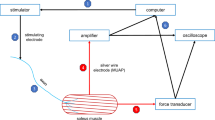Abstract
The maximum tetanic tension (initial strength) and the length of time, 20, 40 or 60%, of that initial strength could be maintained (endurance) was assessed in 2 fast twitch muscles (the plantaris and the medial gastrocnemius) and a slow twitch muscle (the soleus) of the cat at muscle temperatures ranging between 22 and 38°C. The results of these experiments showed that the strength of the soleus was constant between muscle temperatures of 38 to 28°C, and then gradually decreased as the muscle was cooled further. Plantaris, on the other hand, showed a reduction in strength at all muscle temperatures less than 38°C; the response of the medial gastrocnemius was between these two extremes. The longest endurance for the soleus muscle was found to be at a muscle temperature of 28°C, the endurance being as much as 3 times higher at this temperature than at muscle temperatures of 22 or 38°C. The medial gastrocnemius showed a similar response but the endurance only doubled when comparing the endurance at a muscle temperature of 28 to 38°C. In contrast, the plantaris maintained a constant endurance over the temperature range of 38 ot 28°C; below this muscle temperature the endurance decreased markedly. The mechanism for this response appeared to be related to the effect of temperature on the contractile characteristics of the muscles.
Similar content being viewed by others
References
ÜAriano M, Armstrong RB, Edgerton VR (1973) Hindimb muscle fiber populations in five animals. J Histochem Cytochem 21:51–55
Barcroft H, Edholm OG (1946) Temperature and blood flow in the human forearm. J Physiol (Lond) 104:366–376
Bigland B, Lippold OCJ (1954) Motor unit activity in the voluntary contraction of human muscle. J Physiol (Lond) 125:322–335
Buller AJ, Ranatunga KW, Smith JM (1966) The influence of temperature on the contractile characteristics of mammalian fast and slow twitch skeletal muscles. J Physiol (Lond) 196:82P
Clarke RSJ, Hellon RFR, Lind AR (1958) The duration of sustained contractions of the human forearm at different muscle temperatures. J Physiol 143:454–463
Close R, Hoh JRY (1968) Influence of temperature on isometric contractions of rat skeletal muscles. Nature 217:1179–1180
Dubowitz V, Brooke M (1974) Muscle biopsy, a modern approach. W. B. Sanders, Philadelphia
Edwards RHT, Harris RC, Hultman E, Kaiser L, Koh D, Nordesjo L (1972) The effect of temperature on muscle energy metabolism during successive isometric contractions, sustained to fatigue, of the quadriceps muscle in man. J Physiol 220:335–352
Fink R, Luttgau HC (1976) An evaluation of the membrane constants and the potassium conductance in metabolically exhausted muscle fibres. J Physiol 263:215–238
Humphreys PW, Lind AR (1963) The blood flow through active and inactive muscles of the forearm during sustained isometric contractions. J Physiol 166:120
Milner-Brown HS, Stein RB (1975) The relation between the surface electromyogram and muscular force. J Physiol (Lond) 246:549–569
Olson CB, Carpenter DO, Henneman E (1968) Orderly recruitment of muscle action potentials. Arch Neurol (Chicago) 19:591–597
Petrofsky JS (1978) Control of the recruitment and firing frequency in electrically stimulated muscle in the cat. Med Biol Eng Comput 16:392–308
Petrofsky JS, Lind AR (1975a) Insulative power of body fat on deep muscle temperature and isometric endurance. J Appl Physiol 39:639–642
Petrofsky JS, Lind AR (1975b) The relationship of body fat content to deep muscle temperature and isometric endurance in man. Clin Sci Mol Med 48:405–412
Petrofsky JS, Lind R (1979) Isometric endurance in fast and slow muscles in the cat. Am J Physiol 236:C185–191
Petrofsky JS, Weber C, Phillips CA (1979) Electrical and mechanical correlates of isometric fatigue in cat skeletal muscle. Physiologist 22:101
Petrofsky JS, Weber C, Hanpeter D, Phillips CA (1980) Blood flow and metabolic products during fatiguing isometric contractions in fast and slow muscles in the cat. Fed Proc 39:117
Rack PM, Westbury DE (1969) The effect of lengths and stimulus rate on tensions in the isometric cat soleus muscle. J Physiol 204:443–460
Wuerker RB, McPhredran AM, Henneman E (1965) Properties of motor units in a heterogenous pale muscle (M. gastrocnemius) of the cat. J Physiol (Lond) 28:85–99
Author information
Authors and Affiliations
Rights and permissions
About this article
Cite this article
Petrofsky, J.S., Lind, A.R. The influence of temperature on the isometric characteristics of fast and slow muscle in the cat. Pflugers Arch. 389, 149–154 (1981). https://doi.org/10.1007/BF00582106
Received:
Accepted:
Issue Date:
DOI: https://doi.org/10.1007/BF00582106




